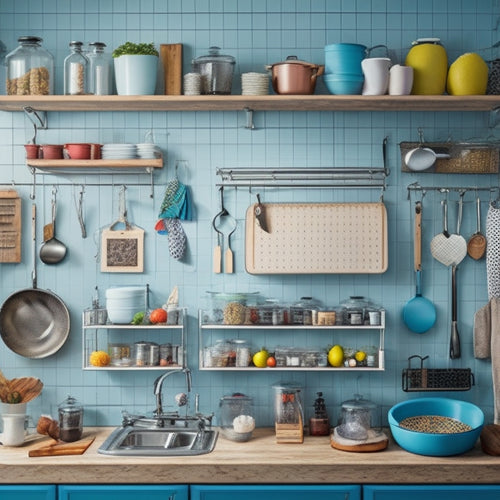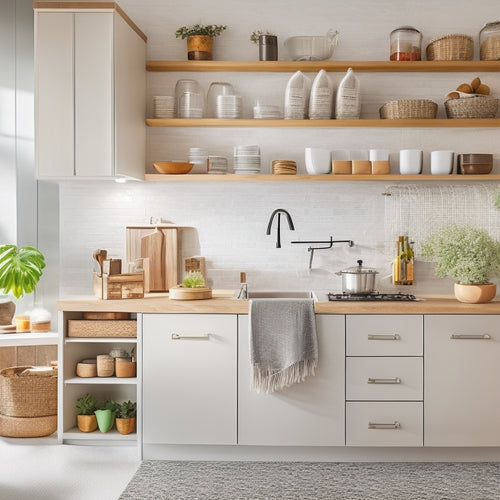
Creating Your Healthy Home: Essential Tips Included
Share
A well-designed and well-maintained home is the cornerstone of a healthy living environment, playing an essential role in protecting the physical and mental well-being of its occupants. To create a healthy home, prioritize fundamental principles like keeping it dry, clean, pest-free, ventilated, and safe. Opt for non-toxic paints, natural flooring, and eco-friendly insulation to guarantee ideal air quality. Regularly check for hidden dangers like mold, radon, and VOCs, and implement safety measures such as smoke detectors and secure furniture. By following these tips, you'll be well on your way to crafting a haven that nourishes both body and mind, and there's even more to discover.
Key Takeaways
• Prioritize healthy materials and sustainable construction practices to create a safe and eco-friendly living space.
• Eliminate hidden dangers like mold, radon, and VOCs by regularly checking for water damage and using eco-friendly products.
• Implement essential principles for a healthy home, including keeping it dry, clean, pest-free, ventilated, and safe.
• Incorporate natural lighting and ensure ideal air quality by using non-toxic paints, natural flooring, and eco-friendly insulation.
• Maintain a safe environment by implementing security measures, storing hazardous materials out of reach, and creating a family emergency plan.
Building a Healthy Foundation
Seven essential principles form the cornerstone of a healthy home. 'Keep it Dry', 'Keep it Clean', 'Keep it Pest Free', 'Keep it Ventilated', and 'Keep it Safe' serve as the foundational pillars that support a thriving and safe living environment.
When building a healthy foundation, it's important to prioritize healthy materials and sustainable construction practices. This includes opting for non-toxic paints, natural flooring, and eco-friendly insulation.
Additionally, incorporating natural lighting and ensuring ideal air quality are crucial components of a healthy home. By doing so, you'll create a space that not only looks beautiful but also promotes the well-being of its occupants.
A well-designed living space can have a significant impact on your health, making it essential to get it right from the start.
Eliminating Hidden Dangers
Beyond the visible threats to a healthy home, hidden dangers lurk in every corner, waiting to compromise the well-being of its occupants. Identifying risks is vital in eliminating these hidden dangers.
One of the most significant threats is indoor pollutants, which can exacerbate respiratory issues and other health problems. Common culprits include mold, radon, and volatile organic compounds (VOCs) from cleaning products and building materials.
To mitigate these risks, it's important to conduct regular checks for water damage, musty odors, and signs of pest infestation. Proper ventilation, air purification systems, and eco-friendly products can also help reduce indoor pollutants.
Maintaining a Safe Environment
A well-maintained home, free from hazards and obstacles, serves as a foundation for a safe environment, where every family member can thrive and feel protected. To achieve this, it is vital to implement security measures such as installing smoke detectors, securing heavy furniture, and storing hazardous materials out of reach. Additionally, emergency preparedness is important, including having a first aid kit, a fire extinguisher, and a family emergency plan.
| Safety Measure | Description |
| Secure heavy furniture | Prevents tip-overs and injuries |
| Install smoke detectors | Early warning system for fires |
| Store hazardous materials | Out of reach from children and pets |
| Create a family emergency plan | Ensures everyone knows what to do in case of an emergency |
| Have a first aid kit | Provides essential medical supplies |
Frequently Asked Questions
How Can I Ensure My Home Is Well-Ventilated to Prevent Moisture Buildup?
To prevent moisture buildup, promote effective air circulation by opening windows, using exhaust fans, and upgrading to a whole-house ventilation system, while maintaining humidity control through the strategic use of dehumidifiers and moisture-absorbing materials.
What Are the Most Effective Ways to Reduce Pest Infestations in My Home?
To prevent pest infestations, seal all entryways, including cracks and crevices, and utilize natural deterrents like essential oils, cinnamon, and mint to repel unwanted intruders, creating a pest-free haven for you and your family.
Can I Reuse or Repurpose Materials During Home Renovations to Reduce Waste?
When renovating, incorporate sustainable design principles by embracing creative reuse of materials, reducing waste, and promoting eco-friendliness. Thoughtfully repurpose items like reclaimed wood, old fixtures, and vintage decor to craft a unique, environmentally responsible space that exudes style and safety.
How Often Should I Check and Replace Air Filters in My Home to Improve Air Quality?
'Time waits for no one, but dirty air filters do! For the best air quality, inspect filters monthly and replace every 1-3 months, depending on usage and manufacturer's guidelines, to breathe easy and maintain a healthy habitat.'
Are There Any Specific Licenses or Permits Required for Home Renovations and Repairs?
When embarking on home renovations and repairs, it is crucial to acquire necessary licenses and permits, ensuring compliance with local Building Codes and paying applicable Permit Fees, to ensure a safe and structurally sound living space.
Related Posts
-

Why Cluttered Kitchens Need Better Tool Storage
You're likely wasting around 30 minutes a day searching for misplaced kitchen tools or utensils, which is equivalent ...
-

Community Engagement: Learning Through Professions
Community engagement is a powerful tool for fostering a deeper understanding of various professions among children. B...
-

Create Your Own Kitchen Countertop Organizer System
To create your own kitchen countertop organizer system, start by evaluating your available counter space, identifying...


